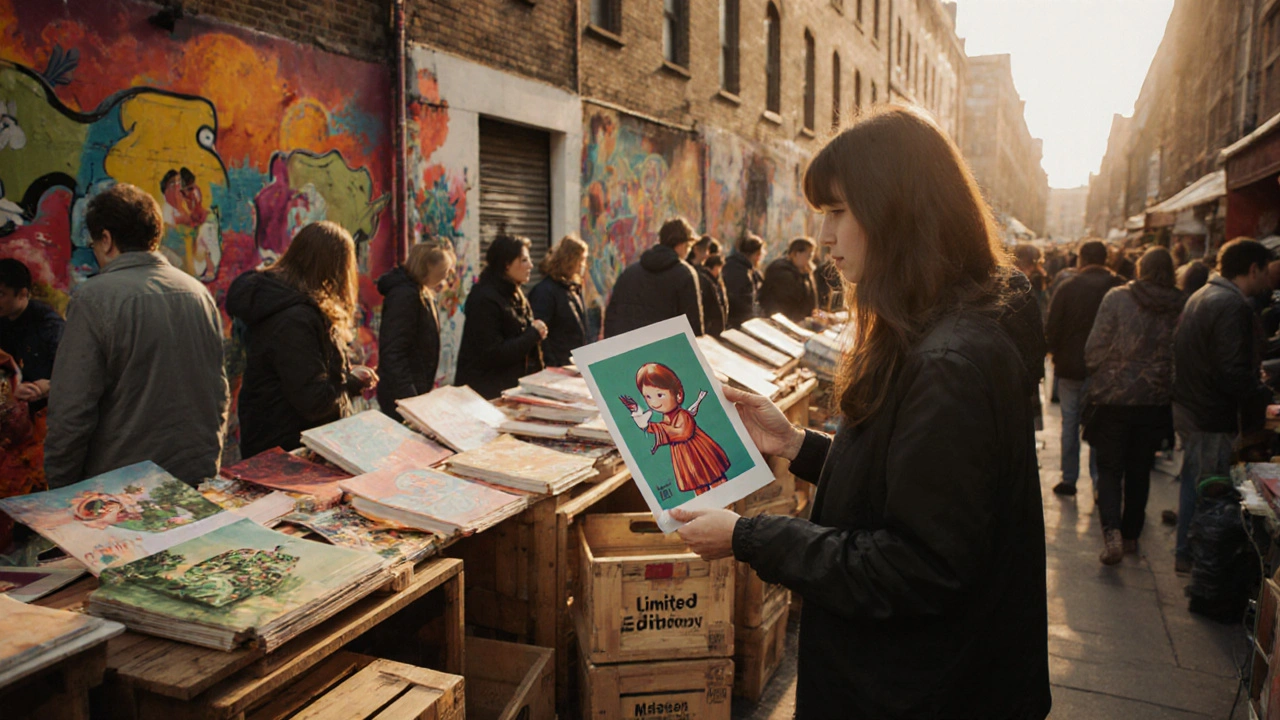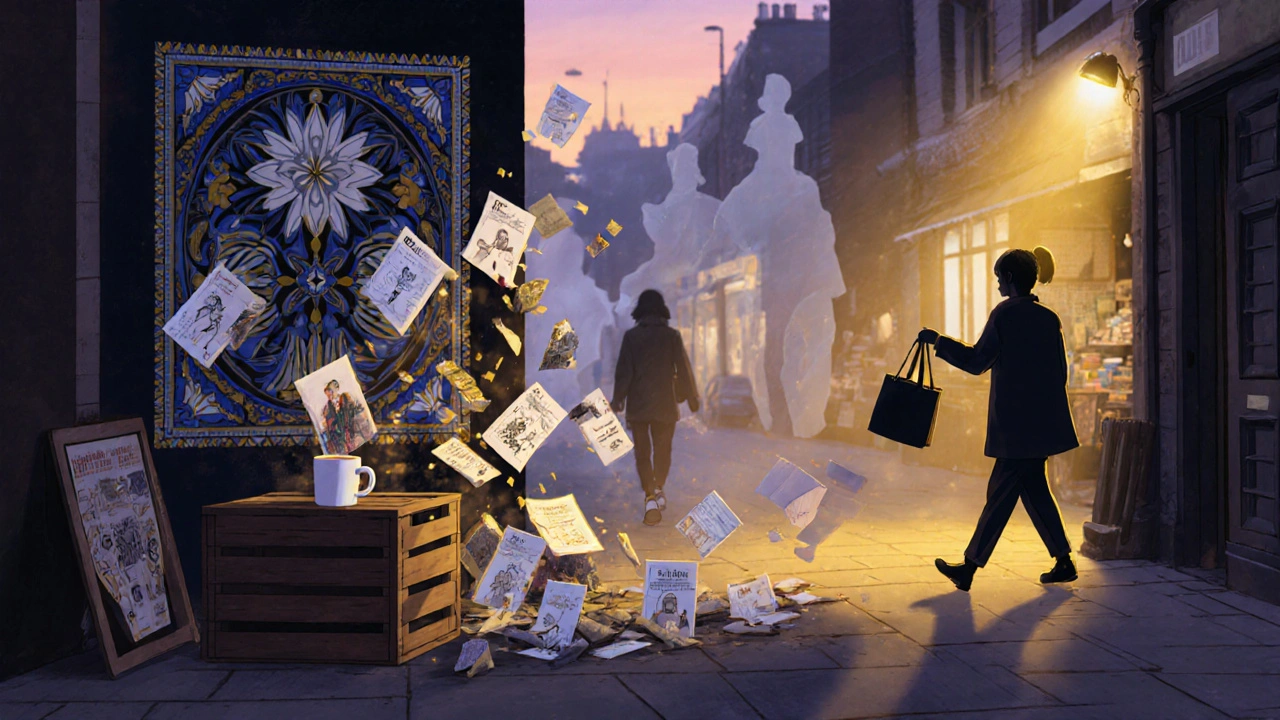
Every autumn, London transforms into an open-air gallery. You don’t need to book tickets or wait in line at a museum. Just walk down a side street in Shoreditch, wander past the arches of Camden, or turn the corner near Bermondsey Street-and suddenly, you’re standing in front of a mural that didn’t exist last week. These aren’t just graffiti tags. They’re curated, temporary art experiences born from festival pop-ups and street art markets that now define London’s creative heartbeat.
Where the Walls Come Alive
Street art in London isn’t random. It’s organized, intentional, and often tied to seasonal events. The biggest players? The London Street Art Festival and the Camden Art Market. Both run from late September through November, syncing with the city’s post-summer energy. Artists from Berlin, Melbourne, and Lagos set up stalls beside local talent from Peckham and Brixton. You’ll find spray-painted canvases, hand-screened posters, resin-coated stencils, and even augmented reality murals you can trigger with your phone.
At the festival’s main hub in Spitalfields, you’ll see artists like Phlegm and Stik selling limited-run prints. These aren’t mass-produced souvenirs. Each piece is numbered, signed, and often comes with a QR code linking to the artist’s story. One woman from Leeds told me she bought a 12x18 inch print of a child holding a bird-made by a former London Underground cleaner turned artist-for £45. She said it was the first piece of art she ever owned that didn’t come from a chain store.
Pop-Ups That Don’t Last
What makes these markets different from regular art fairs? They’re temporary. A pop-up might last three days. Another might vanish after a weekend. That’s the point. The urgency drives demand. Last year, a pop-up in Elephant & Castle sold out of 87 hand-painted ceramic tiles in under two hours. The artist, a 24-year-old from Nigeria named Tobi Adeyemi, had spent six weeks glazing each tile with symbols from Yoruba folklore. By Monday, the space was empty. A coffee shop moved in. No one knew where the tiles went.
These pop-ups often appear in unexpected places: under railway bridges, inside abandoned shops, on the back of delivery vans turned mobile galleries. In 2024, a group called Wall & Word turned a disused phone booth in Hackney into a tiny art gallery. Inside, visitors could buy a 5x5 inch original drawing for £10. One booth sold 212 pieces in 72 hours. The artist? A 17-year-old schoolkid who’d never sold anything before.

How to Find Them
You won’t find these events on Google Maps. They don’t advertise on Instagram ads. Instead, they live in three places:
- Local community boards-check the noticeboards at independent cafés like The Book Club in Peckham or The Lock in Dalston.
- Street art blogs-sites like London Street Art Guide and Urban Sketchers UK update every Thursday with new locations.
- Word of mouth-ask baristas, bookstore clerks, or bike repair shop owners. They know where the artists hang out.
Some events are invite-only. You’ll need to join a mailing list or follow an artist’s Instagram. But most are open to anyone. Just show up. Bring cash. Many artists don’t take cards. And don’t expect signage. The art is the sign.
What You Can Buy (And What You Shouldn’t)
At these markets, you’re not just buying art-you’re buying a moment. Here’s what’s worth it:
- Small originals-under £50. A 6x8 inch screen print, a hand-painted tote, a sticker set. These are affordable and collectible.
- Artist zines-hand-stitched booklets with sketches, poems, and stories. Often under £15. One from a Shoreditch artist called “Letters from the Underground” sold 300 copies last year.
- Local collaborations-like the London Underground x Street Artists series. Limited edition posters based on Tube maps, redrawn with graffiti characters. Only 100 printed.
Avoid the traps:
- Mass-produced prints-if it looks like it came from a Chinese factory, it probably did. Real artists don’t outsource.
- “Signed” knockoffs-some vendors sell fake versions of famous murals. Ask: “Did you paint this?” If they hesitate, walk away.
- Overpriced merch-a £60 hoodie with a stencil of a rat? Probably not worth it. Stick to art you can hang.

Why This Matters
These markets aren’t just about art. They’re about reclaiming space. In a city where rent prices push out small businesses, street art pop-ups give artists a foothold without a lease. They turn alleyways into galleries and parking lots into stages. In 2023, the City of London estimated these events brought £12 million in direct spending to local cafes, bike shops, and independent bookstores.
And they’re changing who gets seen. A 2024 survey by the London Arts Collective found that 68% of artists selling at these markets had never been in a traditional gallery. Half were under 25. One-third were from immigrant backgrounds. This isn’t elite culture. It’s raw, real, and growing.
What’s Next
This year, organizers are testing something new: Art Walks. Every Saturday in November, a free guided tour leaves from Tower Bridge at 11 a.m. You’ll visit five pop-ups in under two hours, meet the artists, and hear their stories. No ticket needed. Just show up. Bring a notebook. Some artists will sketch your face for free if you ask nicely.
By December, most of the art will be gone. The murals will be painted over. The stalls will be packed up. But the photos? The prints? The stories? Those stay. That’s the magic. London’s street art doesn’t live on walls. It lives in the people who stop, look, and buy.
Are street art markets in London open year-round?
Most are seasonal, running from late September through November. A few pop-ups happen in spring, especially around Easter and May Bank Holiday, but the biggest concentration is in autumn. Winter is quiet-artists often take time off or work indoors. Check local blogs like London Street Art Guide for updates.
Can I commission a custom piece at these markets?
Yes, many artists take commissions on the spot. Prices start around £80 for a small canvas or tote bag. Larger pieces-like murals on wood panels-can cost £200-£500. Bring a photo or idea. Most artists work fast and will sketch something while you wait. Payment is usually cash or PayPal QR codes.
Is it safe to visit these street art markets?
Absolutely. These events are well-organized and attract families, tourists, and locals. Areas like Shoreditch, Camden, and Bermondsey are busy and well-lit during market hours. Avoid wandering alone late at night, but daytime visits are perfectly safe. Many markets have security staff and local council support.
Do artists ship internationally?
Most do, but not all. Smaller artists often charge £15-£30 for UK shipping and £40-£70 for international. Some only sell in person to keep costs low. Always ask before buying. If they say yes, get a receipt and tracking number. Many use recycled packaging-part of the art’s story.
What’s the best day to go?
Weekends are busiest, especially Saturday mornings. But if you want fewer crowds and better deals, go on a Friday afternoon. Artists are often willing to negotiate after 4 p.m. as they pack up. Some even offer 20% off to clear stock before closing.